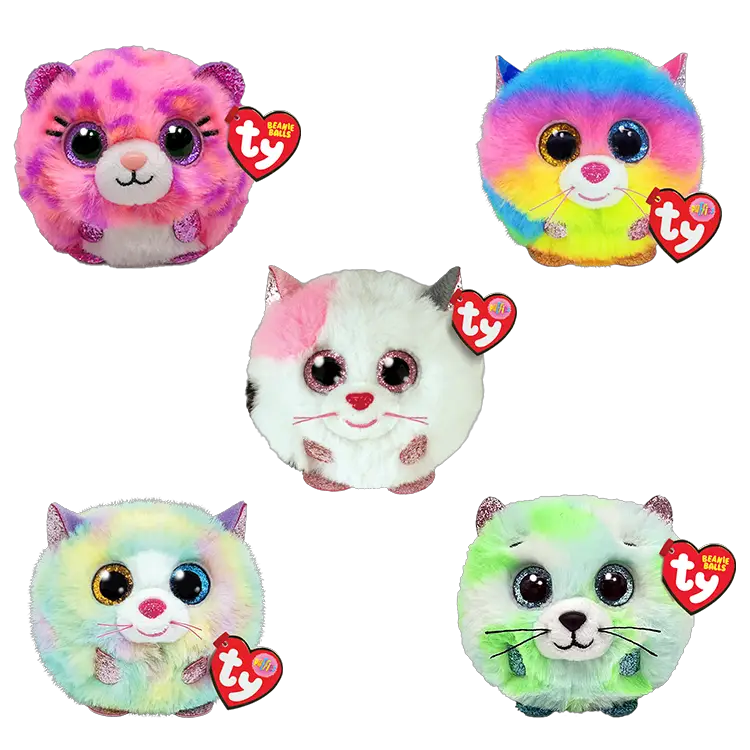In the world of collectibles, few items have captured the hearts and wallets of enthusiasts quite like Beanie Babies. These adorable plush toys, known for their iconic tag and irresistibly soft feel, became a global phenomenon in the 1990s.
While countless Beanie Babies were produced during their heyday, some have skyrocketed in value over the years, making them the most sought-after and valuable treasures among collectors.
In this article, we will explore the realm of Beanie Babies and unveil the 10 most expensive beanie babies in the world, each carrying a price tag that will leave you astounded.
10 Most Expensive Beanie Babies In The World
| No | Most Expensive Beanie Baby | Price |
| 1 | Large Wallace and his Squad | $600,000 |
| 2 | Princess the Bear | $500,000 |
| 3 | 15-inch Peace bear and 9-inch Peace, Ringo and Bones | $159,000 |
| 4 | Bubbles | $129,000 |
| 5 | Piccadilly Attic |
$125,000
|
| 6 | Lefty the Donkey and Righty the Elephant |
$50,000
|
| 7 | Valentino the Bear | $42,300 |
| 8 | Hippity, Hoppity and Floppity the Bunnies | $30,000 |
| 9 | Brownie the Bear | $20,000 |
| 10 | Iggy the Iguana | $15,000 |
Large Wallace and his Squad
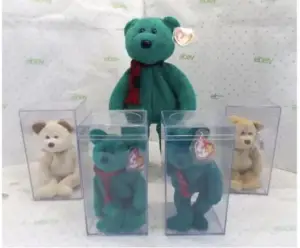
Large Wallace and his Squad is the most expensive beanie baby in the world. Let me introduce you to Large Wallace and his remarkable squad of Beanie Babies, a legendary ensemble that has captured the hearts and imaginations of collectors around the globe. At the helm stands Large Wallace, a majestic bear with a plush coat of rich blue fur and an undeniable aura of charm.
Alongside him, his squad comprises a cast of extraordinary companions, each possessing a distinct personality and allure. From the elegant Princess Bear, adorned with a crown befitting her royal status, to the whimsical Humphrey the Camel, with his intricate humps and enigmatic smile, this squad embodies the pinnacle of Beanie Baby collectibles.
Together, Large Wallace and his squad have amassed a cult-like following, mesmerizing enthusiasts with their rarity and commanding staggering prices in the competitive world of Beanie Babies collecting.
Princess the Bear
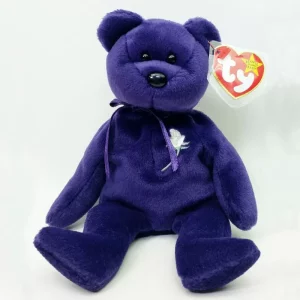
Princess the Bear is the 2nd most expensive beanie baby in the world. Allow me to introduce you to the enchanting Princess Bear, a beloved member of the illustrious Beanie Babies family. With her exquisite design and regal presence, Princess holds a special place in the hearts of collectors worldwide.
Adorned with a shimmering purple coat and a magnificent crown on her head, she exudes an air of grace and elegance that is truly unparalleled. Released in 1997 as a tribute to the late Princess Diana, this iconic Beanie Baby quickly became a symbol of admiration and remembrance.
Princess holds a cherished position as one of the most sought-after and valuable Beanie Babies ever produced. Her extraordinary popularity and limited availability have propelled her into the realm of legendary collectibles, commanding astounding prices in the market.
15-inch Peace bear and 9-inch Peace, Ringo and Bones
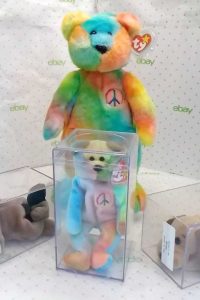
15-inch Peace Bear and 9-inch Peace, Ringo and Bones is the 3rd most expensive beanie baby in the world. These endearing plush toys have captured the hearts of collectors with their irresistible appeal. The 15-inch Peace bear stands tall, boasting a vibrant tie-dye coat that symbolizes peace, love, and harmony. Its smaller counterpart, the 9-inch Peace, shares the same captivating design in a more compact form, perfect for cuddling.
Joining them is Ringo the raccoon, with its distinctive black and white fur and mischievous charm. Completing the quartet is Bones the Dog, whose floppy ears and loyal expression add an adorable touch.
Together, they form a playful and lovable group that embodies the essence of Beanie Babies. These cherished companions have not only captured the hearts of collectors but also garnered significant value in the market.
Bubbles
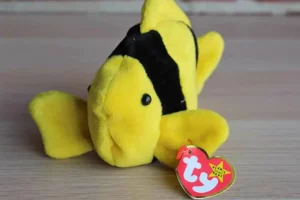
Bubbles are the 4th most expensive beanie baby in the world. Bubbles, a whimsical and lovable dolphin, brings a sense of joy and playfulness to any collection. With its vibrant blue body, sparkling eyes, and friendly smile, Bubbles is an embodiment of the carefree spirit of the ocean.
Released in 1996, this enchanting Beanie Baby quickly made a splash in the world of collectibles, captivating both children and adults alike. Its undeniable charm and exquisite craftsmanship have cemented its status as a cherished treasure.
Bubbles represent not only the fascinating marine world but also the enduring appeal of Beanie Babies as timeless companions.
Piccadilly Attic
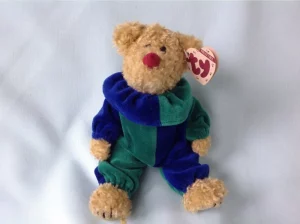
Piccadilly Attic is the 5th most expensive beanie baby in the world. Within the enchanting walls of Piccadilly Attic, a treasure trove of Beanie Babies awaits collectors and enthusiasts alike. This whimsical boutique boasts a remarkable collection of these iconic plush toys, each one carefully selected and displayed with care. From the beloved classics that sparked a craze in the 1990s to the rare and sought-after editions, Piccadilly Attic holds a coveted array of Beanie Babies that ignite the passion of collectors.
Whether you’re in search of a missing piece for your collection or a nostalgic throwback to your childhood, Piccadilly Attic offers a haven where Beanie Babies come to life once more. Allow yourself to wander through the aisles, basking in the joy and nostalgia of these cherished companions. Each Beanie Baby at Piccadilly Attic carries a story, waiting to be discovered and embraced by those who appreciate the magic that these lovable plush toys bring.
Lefty the Donkey and Righty the Elephant
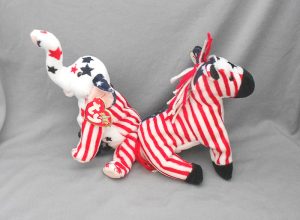
Lefty the Donkey and Righty the Elephant is the 6th most expensive beanie baby in the world. Lefty, with its soft gray fur and friendly expression, while Righty, with its strong presence and proud stance. Released during the fervor of the 2000 presidential election, Lefty and Righty quickly became sought-after treasures for Beanie Baby enthusiasts. Lefty the Donkey and Righty the Elephant reminds us of the importance of embracing diverse perspectives.
Valentino the Bear
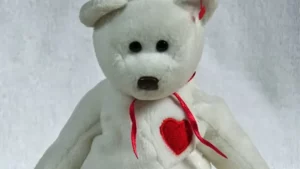
Valentino the Bear is the 7th most expensive beanie baby in the world. Valentino, with its rich burgundy fur and endearing expression, is an embodiment of love and affection. Released in 1994, this beloved bear quickly became a symbol of romance and adoration. It’s velvety texture and huggable size make it an irresistible companion for both children and adults alike.
Valentino holds a special place in the hearts of Beanie Baby enthusiasts, with its name evoking sentiments of love and cherished memories. Its popularity and scarcity have propelled it to legendary status, making it one of the most sought-after and valuable Beanie Babies ever produced.
Hippity, Hoppity and Floppity the Bunnies
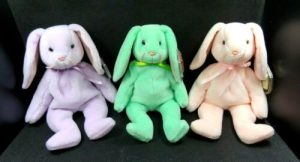
Hippity, Hoppity and Floppity the Bunnies is the 8th most expensive beanie baby in the world. Allow me to introduce you to a trio of adorable Beanie Babies: Hippity, Hoppity, and Floppity, the bunnies that have captured the hearts of collectors around the world. These lovable plush toys embody the spirit of springtime and the joy of Easter. Hippity, with its vibrant green fur, Hoppity, with its soft pink coat, and Floppity, with its delicate lavender hue, brings a burst of color and cheer wherever they hop.
Released in 1996 as part of the Beanie Babies collection, these bunnies quickly became a symbol of the season, delighting both children and collectors alike. Their floppy ears, twinkling eyes, and irresistibly cuddly nature make them cherished companions. Whether displayed as Easter decorations or treasured additions to a Beanie Baby collection, Hippity, Hoppity, and Floppity radiate the joy and innocence of spring, reminding us of the magic and happiness that these charming creatures bring to our lives.
Brownie the Bear
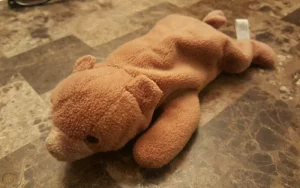
Brownie the Bear is the 9th most expensive beanie baby in the world. Brownie, with its soft cocoa-colored fur and friendly expression, exudes warmth and charm. Released in 1993, this iconic bear quickly became a cherished companion for children and a coveted treasure for collectors. Brownie’s endearing design, complete with a cute button nose and a sweet smile, evokes feelings of comfort and nostalgia.
Whether displayed on a shelf or snuggled tightly in the arms of its owner, Brownie brings a sense of joy and companionship. Its timeless appeal and limited availability have made it a sought-after gem among Beanie Baby enthusiasts.
Iggy the Iguana
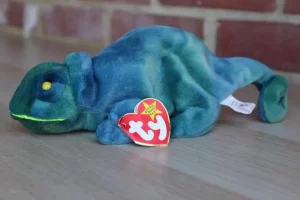
Iggy the Iguana is the 10th most expensive beanie baby in the world. Iggy, with its vibrant green scales and striking rainbow tie-dye patterns, stands out as a truly one-of-a-kind plush toy. Released in 1997, this whimsical iguana quickly became a fan favorite, enchanting both children and adults with its playful appearance.
Iggy’s endearing expression and velvety texture make it a delightful companion for imaginative play and cuddles alike. As one of the more colorful and distinctive Beanie Babies, Iggy has carved a special place in the hearts of collectors, who admire its eye-catching design and cheerful personality.
Frequently Asked Questions
Where to sell beanie babies?
There are several options available for selling Beanie Babies. Here are a few popular avenues:
1. Online Marketplaces: Websites like eBay, Etsy, and Amazon provide a platform for individuals to sell Beanie Babies directly to buyers. These platforms allow you to create listings, set your prices, and reach a wide audience of potential customers.
2. Collectible Marketplaces: There are dedicated online marketplaces specifically for collectibles, such as WorthPoint, Collector’s Corner, and Ruby Lane. These platforms cater to collectors and may attract buyers with a specific interest in Beanie Babies.
3. Social Media Groups and Forums: Joining Beanie Baby-focused groups on platforms like Facebook or participating in relevant forums can connect you with fellow collectors who might be interested in purchasing or trading Beanie Babies.
4. Consignment Stores and Auction Houses: Local consignment stores and auction houses that specialize in collectibles or toys may be interested in selling your Beanie Babies on your behalf. They will typically take a percentage of the final sale price as a commission.
5. Local Events and Flea Markets: Consider setting up a booth at local events, flea markets, or craft fairs to showcase and sell your Beanie Babies. These venues can attract collectors and offer the opportunity for face-to-face interactions with potential buyers.
Remember to research the market value of specific Beanie Babies before selling to ensure you’re getting a fair price. Additionally, accurately describing the condition of your Beanie Babies and providing clear photographs can help attract potential buyers.
How to sell beanie babies?
To sell Beanie Babies, you can follow these steps:
1. Research and Assess: Begin by researching the current market value of the Beanie Babies you wish to sell. Online platforms like eBay and WorthPoint can provide insights into recent sales and pricing trends. Assess the condition of each Beanie Baby to determine its value.
2. Gather Information: Create a detailed inventory of the Beanie Babies you plan to sell, noting any special features, tags, or unique attributes. Take clear and well-lit photographs of each Beanie Baby to include in your listings.
3. Choose a Selling Platform: Decide where you want to sell your Beanie Babies. Online marketplaces like eBay, Etsy, or Amazon offer broad visibility, while specialized collectible marketplaces like WorthPoint or Ruby Lane cater specifically to collectors. Social media groups, local events, consignment stores, and auction houses are also options to consider.
4. Set Prices: Determine a fair and competitive price for each Beanie Baby based on market research. Consider factors such as rarity, condition, demand, and any unique features. You can choose to list items at a fixed price or use an auction-style listing to allow buyers to bid on them.
5. Create Listings: If selling online, create detailed and accurate listings for each Beanie Baby. Include important information such as its name, tag condition, year of release, and any notable characteristics. Use high-quality photos to showcase the Beanie Babies from different angles.
6. Shipping and Packaging: If selling online, familiarize yourself with the shipping process. Ensure you have appropriate packaging materials, such as padded envelopes or boxes, to protect the Beanie Babies during transit. Calculate and include shipping costs in your listings.
7. Promote Your Listings: Share your listings on social media platforms, in relevant collector groups, or with friends and family to increase visibility and attract potential buyers. Highlight any unique or rare Beanie Babies you have for sale.
8. Communication and Sales: Promptly respond to inquiries and messages from potential buyers. Be transparent about the condition and details of the Beanie Babies. Once a sale is made, securely package the item and ship it to the buyer within the agreed timeframe.
9. Customer Service: Provide excellent customer service by promptly addressing any concerns or issues that arise. Maintain open communication throughout the transaction process.
Remember to comply with the policies and guidelines of the selling platform you choose, and always prioritize honesty and professionalism in your interactions with buyers.
Who buys beanie babies?
Various types of people buy Beanie Babies, including collectors, enthusiasts, and individuals looking for nostalgic items or gifts. Here are some common categories of buyers:
1. Collectors: Many Beanie Baby buyers are passionate collectors who actively seek out specific Beanie Babies to add to their collections. These collectors often have a deep appreciation for the history, rarity, and unique qualities of each Beanie Baby.
2. Enthusiasts: Some buyers are simply enthusiasts who enjoy the charm and nostalgia of Beanie Babies. They may not have extensive collections but appreciate the cuteness and sentimental value of these plush toys.
3. Parents and Gift Buyers: Beanie Babies are popular among parents and gift buyers who seek adorable and collectible items for their children or loved ones. They may be drawn to the endearing designs, soft textures, and the opportunity to introduce a piece of their childhood to a new generation.
4. Resellers: Certain buyers purchase Beanie Babies to resell them at a later time. These individuals may have a keen understanding of the market and aim to capitalize on the demand and collectible nature of certain Beanie Babies.
5. Fans of Specific Characters or Designs: Some buyers are drawn to particular Beanie Babies based on their favorite characters, animals, or designs. Whether it’s a preference for teddy bears, animals like dolphins or dogs, or even characters from movies or books, these buyers are specifically seeking out Beanie Babies that resonate with their interests.
It’s important to note that the Beanie Baby market has evolved over the years, and the demand for specific Beanie Babies can fluctuate. While some Beanie Babies have retained or increased in value, others may have more sentimental or nostalgic appeal rather than monetary worth.
What are beanie babies worth?
The value of Beanie Babies can vary widely and depends on several factors, including rarity, condition, age, and demand among collectors. While some Beanie Babies have retained or increased in value over the years, it’s important to note that the Beanie Baby market has experienced significant shifts since its peak in the 1990s. Here are some general guidelines to consider:
1. Rare and Limited Edition Beanie Babies: Certain Beanie Babies, such as early prototypes, retired editions, or those with production errors, can hold higher value among collectors. Limited releases, special editions, or Beanie Babies with unique features or tags may also command higher prices.
2. Condition: Beanie Babies in mint condition with original tags tend to be more valuable. The tag should be intact, legible, and untampered with. Additionally, the overall condition of the plush itself, including cleanliness and lack of damage, can influence value.
3. Market Demand: The popularity and demand for specific Beanie Babies can greatly impact their worth. Factors such as nostalgia, current trends, and collector interests can influence demand and subsequently affect prices.
4. Authentication and Grading: Beanie Babies that have been authenticated and graded by reputable grading companies may carry additional value, as they provide a professional assessment of their authenticity and condition.
To determine the value of a specific Beanie Baby, it is advisable to consult reputable pricing guides, online marketplaces, and collector communities that specialize in Beanie Babies. However, please note that the listed prices may vary, and it’s important to consider recent sales and market trends to get a more accurate estimation of the current value.
When did beanie babies come out?
Beanie Babies were first introduced to the market in 1993 by Ty Inc., a company founded by Ty Warner. The initial release included nine Beanie Babies, which consisted of a combination of animals like Spot the Dog, Squealer the Pig, and Patti the Platypus. These early Beanie Babies quickly gained popularity and paved the way for the Beanie Baby craze that reached its peak in the mid-1990s. Over the years, Ty Inc. continued to release new Beanie Babies with different designs, limited editions, and themed collections, captivating the hearts of collectors worldwide. The Beanie Baby phenomenon sparked a cultural phenomenon that remains a significant part of pop culture history.

